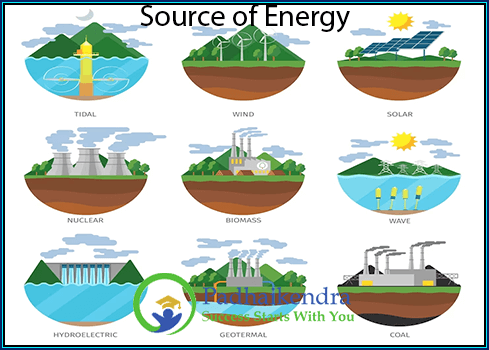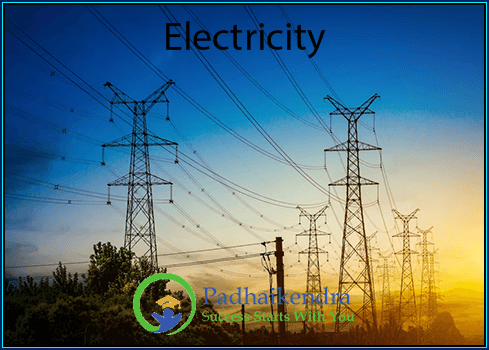In our modern world, energy is the driving force behind technological advancements and economic growth. The demand for energy is continuously increasing, necessitating a diverse array of energy sources. From traditional fossil fuels to cutting-edge renewable technologies, let us explore the various sources of energy and shed light on their advantages, disadvantages, and sustainability-
Fossil Fuels
 Fossil fuels, including coal, oil, and natural gas, have been the backbone of global energy consumption for centuries. These non-renewable resources are formed from the remains of ancient plants and animals. Fossil fuels offer high energy density, affordability, and reliable power generation. However, their extensive use contributes to greenhouse gas emissions, air pollution, and environmental degradation. The finite nature of fossil fuels necessitates a transition towards more sustainable alternatives.
Fossil fuels, including coal, oil, and natural gas, have been the backbone of global energy consumption for centuries. These non-renewable resources are formed from the remains of ancient plants and animals. Fossil fuels offer high energy density, affordability, and reliable power generation. However, their extensive use contributes to greenhouse gas emissions, air pollution, and environmental degradation. The finite nature of fossil fuels necessitates a transition towards more sustainable alternatives.
Nuclear Energy
 Nuclear energy harnesses the power of atomic reactions to generate electricity. It involves nuclear fission, where the nucleus of an atom is split, releasing a tremendous amount of energy. Nuclear power plants offer significant energy output, operate continuously, and produce minimal greenhouse gas emissions. However, concerns surrounding the safe disposal of radioactive waste, potential accidents, and the proliferation of nuclear weapons persist. Stringent safety measures and proper waste management are crucial for the sustainable utilization of nuclear energy.
Nuclear energy harnesses the power of atomic reactions to generate electricity. It involves nuclear fission, where the nucleus of an atom is split, releasing a tremendous amount of energy. Nuclear power plants offer significant energy output, operate continuously, and produce minimal greenhouse gas emissions. However, concerns surrounding the safe disposal of radioactive waste, potential accidents, and the proliferation of nuclear weapons persist. Stringent safety measures and proper waste management are crucial for the sustainable utilization of nuclear energy.
Renewable Energy
Renewable energy sources, such as solar, wind, hydroelectric, geothermal, and tidal power, have gained prominence due to their abundant availability and minimal environmental impact. These sources derive energy from natural processes that can be naturally replenished. Solar energy harnesses sunlight, wind energy utilizes wind currents, hydroelectric power captures the energy of flowing water, geothermal energy exploits Earth’s internal heat, and tidal power harnesses the energy from ocean tides. Renewable energy offers clean, inexhaustible power, mitigates climate change, and enhances energy security. However, intermittent availability, high initial costs, and the need for advanced infrastructure remain challenges to be addressed.
“Read about Renewable and Non-Renewable Sources of Energy”
Hydrogen
Hydrogen, often dubbed the “fuel of the future,” is a versatile energy carrier that can be produced from various sources, including fossil fuels, biomass, and electrolysis of water. It can be used directly or converted into electricity to power vehicles and generate heat and electricity. Hydrogen fuel cells emit only water vapor, making them environmentally friendly. However, widespread hydrogen adoption requires efficient production methods, cost reduction, and an extensive infrastructure for storage and distribution.
Biofuels
 Biofuels are derived from renewable biological resources such as plants, algae, and organic waste. They can be in the form of bioethanol, biodiesel, or biogas. Biofuels offer a viable alternative to fossil fuels, reduce greenhouse gas emissions, and promote agricultural sustainability. However, concerns over land use, deforestation, food security, and the energy required for their production pose challenges that must be addressed to ensure their sustainability.
Biofuels are derived from renewable biological resources such as plants, algae, and organic waste. They can be in the form of bioethanol, biodiesel, or biogas. Biofuels offer a viable alternative to fossil fuels, reduce greenhouse gas emissions, and promote agricultural sustainability. However, concerns over land use, deforestation, food security, and the energy required for their production pose challenges that must be addressed to ensure their sustainability.
Natural Gas
 Natural gas, primarily composed of methane, is a cleaner-burning fossil fuel compared to coal and oil. It is used for electricity generation, heating, and as a transportation fuel. Natural gas offers lower greenhouse gas emissions and higher energy efficiency. However, its extraction through hydraulic fracturing (fracking) raises environmental concerns such as water contamination and methane leaks. Transitioning to renewable energy sources remains crucial for a sustainable future.
Natural gas, primarily composed of methane, is a cleaner-burning fossil fuel compared to coal and oil. It is used for electricity generation, heating, and as a transportation fuel. Natural gas offers lower greenhouse gas emissions and higher energy efficiency. However, its extraction through hydraulic fracturing (fracking) raises environmental concerns such as water contamination and methane leaks. Transitioning to renewable energy sources remains crucial for a sustainable future.
Electricity
 Electricity, although not a primary source of energy, plays a significant role as a versatile and efficient carrier of energy. It can be generated from various sources, including fossil fuels, nuclear power, and renewable energy. Electricity enables the operation of electric vehicles, appliances, lighting, and other electronic devices. The decarbonization of electricity generation through renewable sources is essential for achieving a clean energy transition.
Electricity, although not a primary source of energy, plays a significant role as a versatile and efficient carrier of energy. It can be generated from various sources, including fossil fuels, nuclear power, and renewable energy. Electricity enables the operation of electric vehicles, appliances, lighting, and other electronic devices. The decarbonization of electricity generation through renewable sources is essential for achieving a clean energy transition.
The world’s energy landscape is evolving, driven by the need for sustainable and environmentally friendly alternatives. Fossil fuels, nuclear energy, renewable energy sources, hydrogen, biofuels, natural gas, and electricity each contributes to meeting our energy demands. While fossil fuels and nuclear energy continue to play a significant role, the transition towards cleaner and renewable sources is vital to mitigate climate change and ensure a sustainable future. Investing in research, development, and deployment of innovative technologies will pave the way for a diversified, efficient, and eco-friendly global energy system.
Sources of energy can be classified as :
- Renewable Sources of Energy
- Non-Renewable Sources of Energy





